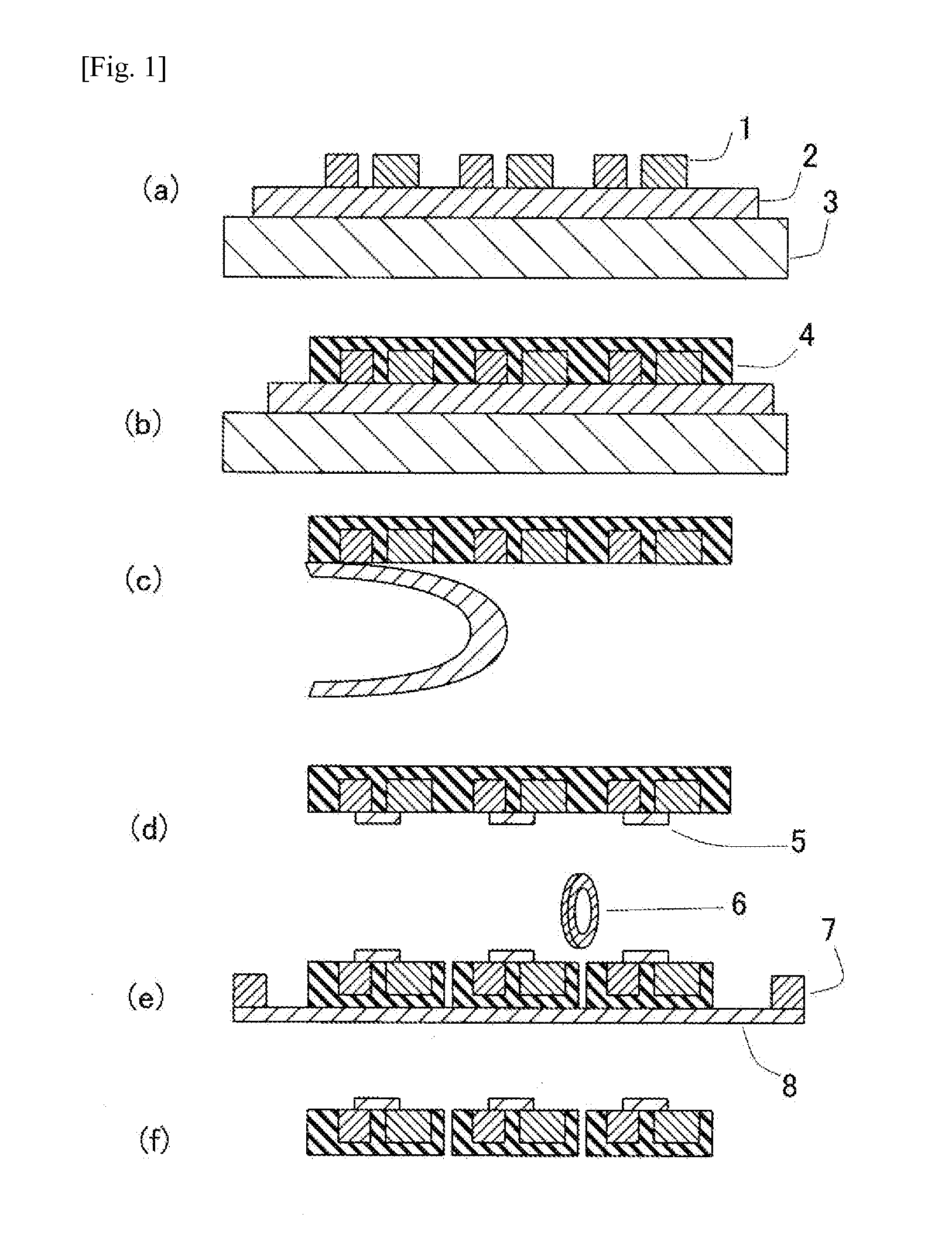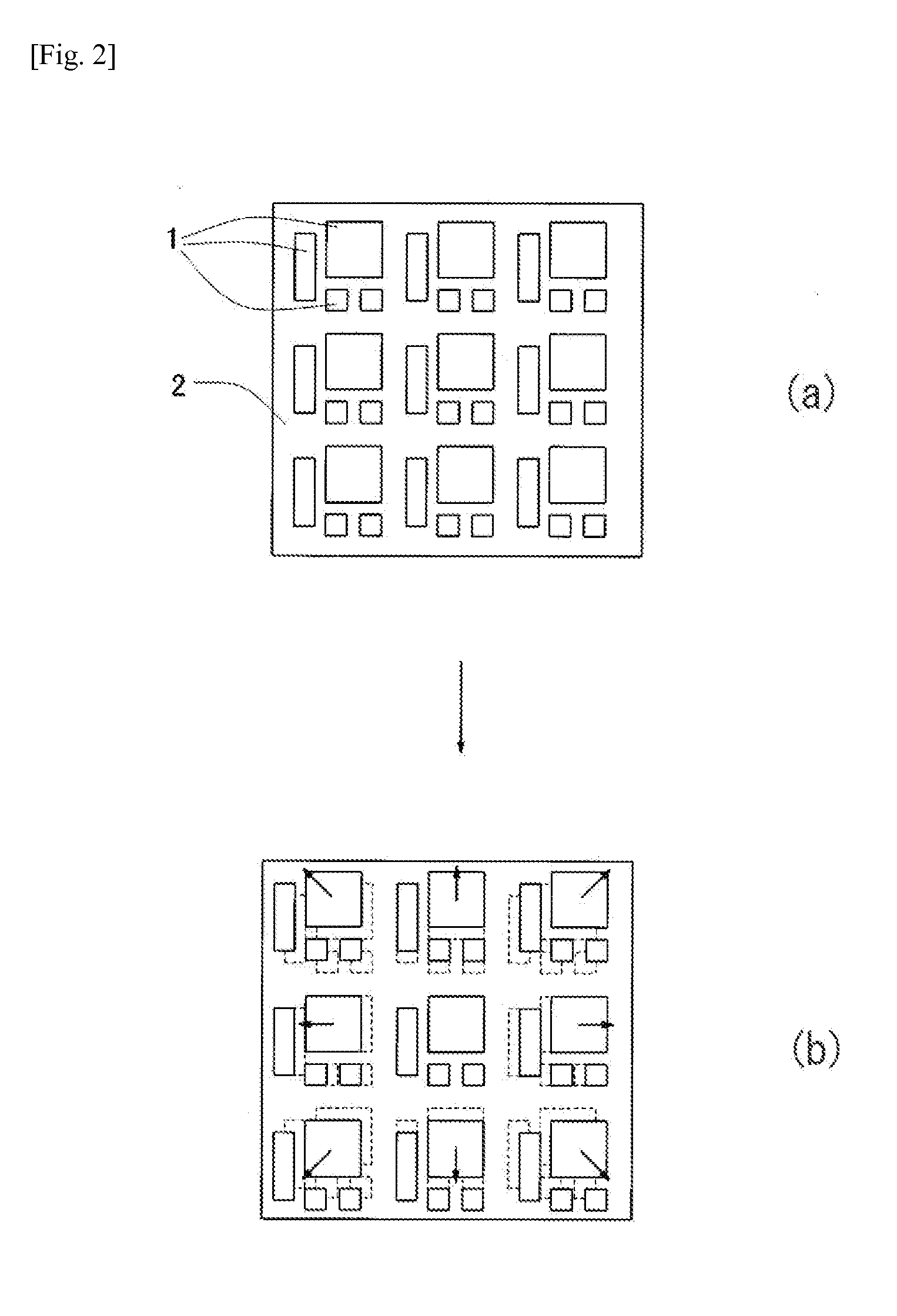Heat-resistant adhesive sheet for substrateless semiconductor package fabrication and method for fabricating substrateless semiconductor package using the adhesive sheet
- Summary
- Abstract
- Description
- Claims
- Application Information
AI Technical Summary
Benefits of technology
Problems solved by technology
Method used
Image
Examples
working examples
[Measuring Method]
[0116]Measurements and evaluations in working examples and comparative examples were made as follows.
[0117]Initial adhesion strength to SUS: Peel adhesion strength to a SUS304BA plate at an angle of 180° at room temperature
[0118]Adhesion strength to SUS304 after heating: Peel adhesion strength at an angle of 180° after attached to a SUS304BA plate and heated at 150° C. for 60 minutes
[0119]Adhesion strength to SUS304 at 175° C.: Peel adhesion strength to a SUS304BA plate at 175° C.
[0120]Peel strength from package: Peel adhesion strength at an angle of 180° when the adhesive sheet is peeled from the package
[0121]Chip displacement: Displacement from the initial position of a chip measured with a digital microscope after package fabrication
[0122]Adhesive deposit: The surface of the package was visually checked for adhesive deposits after the adhesive sheet was peeled off.
[0123]The term “part” in the following description means “part by weight”.
working example 1
[0124]3 pts.wt. of acrylic acid monomer as a component monomer was blended with 100 pts.wt. of butyl acrylate monomer to derive an acrylic-based copolymer. 3 pts.wt. of an epoxy-based cross-linking agent (Tetrad-C from Mitsubishi Gas Chemical Company, Inc.) and 5 pts.wt. of an isocyanate-based cross-linking agent (Coronate L from Nippon Polyurethane Industry Co., Ltd.) were blended with 100 pts.wt. of the acrylic-based copolymer to prepare an acrylic-based adhesive. 50 pts.wt. of a UV curable compound (UV-1700B from Nippon Synthetic Chemical Industry Co., Ltd.) and 3 pts.wt. of UV curing initiator (Irgacure 651 from NAGASE & CO., LTD.) were added to the acrylic-based adhesive to prepare an adhesive composition.
[0125]Then, the adhesive composition was applied to a 25-μm-thick polyimide film (Kapton 100H from Du Pont-Toray Co., Ltd.) serving as the base material layer, and then dried to prepare a heat-resistant adhesive sheet for semiconductor device fabrication with an adhesive layer...
working example 2
[0136]42 parts of acrylonitrile-butadiene rubber (Nipol 1072) from Zeon Corporation), 53 parts of bisphenol A-type epoxy resin (Epikote 828 from Japan Epoxy Resin Co., Ltd., with a weight per epoxy equivalent of 190 g / eq), and 5 parts of imidazole (C1 1Z from Shikoku Chemicals Corporation) were blended and dissolved in an MEK solvent to a concentration of 35 wt % to prepare a bond solution. The bond solution was applied to a 35-μm-thick copper foil serving as a base material film, and was then dried at 150° C. for 3 minutes to form a bond layer having a bond thickness of 10 μm, thus forming a heat-resistant adhesive sheet for semiconductor device fabrication.
[0137]A 3 mm×3 mm Si wafer chip was placed on the heat-resistant adhesive sheet for semiconductor device fabrication, epoxy-based encapsulation resin powder (GE-740LA from Nitto Denko Corporation) was sprinkled over the sheet and the wafer chip, and then molded by heating at a temperature of 175° C. under a pressure of 3.0 kg / cm...
PUM
| Property | Measurement | Unit |
|---|---|---|
| Energy | aaaaa | aaaaa |
| Pressure | aaaaa | aaaaa |
| Electrical resistance | aaaaa | aaaaa |
Abstract
Description
Claims
Application Information
 Login to View More
Login to View More - R&D
- Intellectual Property
- Life Sciences
- Materials
- Tech Scout
- Unparalleled Data Quality
- Higher Quality Content
- 60% Fewer Hallucinations
Browse by: Latest US Patents, China's latest patents, Technical Efficacy Thesaurus, Application Domain, Technology Topic, Popular Technical Reports.
© 2025 PatSnap. All rights reserved.Legal|Privacy policy|Modern Slavery Act Transparency Statement|Sitemap|About US| Contact US: help@patsnap.com



